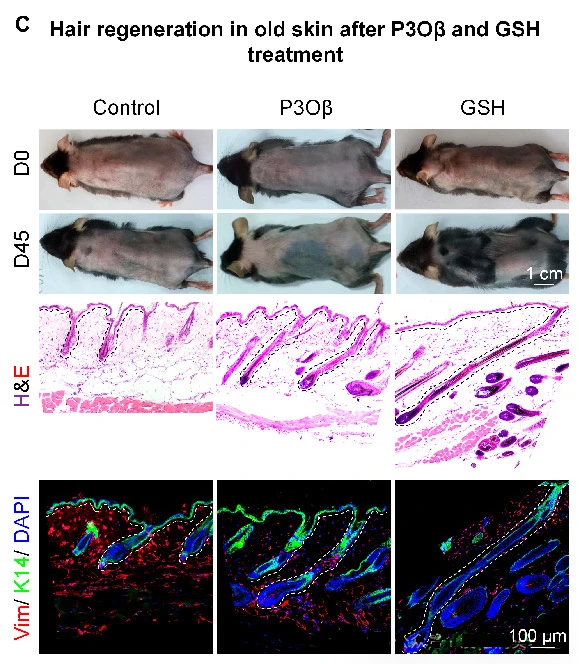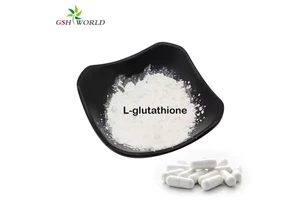Mitochondrial autophagy activates glutathione metabolism and promotes hair regeneration
Hair follicles are small epithelial organs of the skin that maintain hair regeneration during the hair cycle (divided into resting, growing, and degenerative stages).
During the transition from resting to growing phase of the hair cycle, the hair embryo (HG) first senses signals from the microenvironment and multiplies earlier than the cells in the raised area, providing energy and becoming the main link in the initial steps of hair regeneration.
This process is involved in a lot of metabolic energy consumption.
Autophagy, as a dynamic circulatory system, generates new building blocks and energy for cell renewal and homeostasis.
Mitochondrial autophagy is essential for tissue regeneration, and it is a sufficient and necessary condition for hair regeneration.
The study found that applying small molecules that activate autophagy to the back of a hair shedding mouse model promoted hair regeneration.

On August 1, 2024, Professor Lei Mingxing team of Chongqing University published a comprehensive TOP journal Research (District 1, Chinese Academy of Sciences, IF=11) publish an article entitled Mitophagy Promotes Hair Regeneration by Activating Glutathione Metabolism, It was found that mitochondrial autophagy promoted the proliferation of hair embryo (HG) cells by regulating glutathione (GSH) metabolism.
The development and hair regeneration process of hair follicle stem cells (HFSC) cannot be separated from metabolism, in which lactate dehydrogenase activity can accelerate the activation and hair cycle of hair follicle stem cells (HFSC).
Glutathione (GSH) plays an important role in stem cell differentiation and cell proliferation.
Down-regulation of glutathione (GSH) metabolism can enhance and stabilize stem cell differentiation, and stem cells with higher GSH content have stronger dryability, metastasis and proliferation.
Increased expression of glutamate-cysteine ligase catalyzed subunit (GCLC) and solute carrier family member SLC7A11 regulates glutathione (GSH) metabolism, promotes glutathione (GSH) synthesis, and significantly increases the proliferation of Warburg macroglobulinemia cells.
In this study, to explore the role of mitochondrial autophagy in hair regeneration, the researchers analyzed mouse hair follicles in the dormant and early growth stages, and observed enhanced mitochondrial autophagy activity in the hair embryo (HG) in the early growth stages.
Functional studies using hair removal, shaving, and skin organoid models have shown that hair embryo (HG) cells first initiate mitochondrial autophagy to eliminate mitochondria that may be damaged by apoptosis during the degenerative phase.
Mitochondrial autophagy promotes hair cycle transition and accelerates hair regeneration by regulating glutathione (GSH) metabolism, which provides energy for hair embryo (HG) cell proliferation.
Aging hair embryo (HG) cells can also be reactivated for regeneration after activation of mitochondrial autophagy or glutathione (GSH) metabolism.
This study revealed that mitochondrial autophagy regulates the process of hair regeneration by regulating glutathione (GSH) metabolism, which opens up a new way to solve the problem of hair loss affecting humans.

FIG. 1 Schematic diagram of hair regeneration (increased mitochondrial autophagy activity in hair embryo during the transition from resting to early growth phase of hair follicles)
Statin 2
During mitochondrial depolarization or proteasome-dependent outer membrane rupture, inhibin 2 (PHB2) binds to LC3 via the LC3 interaction domain and participates in targeted mitochondrial autophagy degradation.
Statin 2 (PHB2) plays an important role in maintaining mitochondrial metabolism and repairing mitochondrial damage. Overexpression of statin 2 (PHB2) can activate mitochondrial autophagy and restore mitochondrial activity.
Conversely, low expression or inhibition of statin 2 (PHB2) down-regulates mitochondrial autophagy.
The researchers shaved hair from the back skin of 7-week-old C57BJ-6 mice and administered it with a small molecule (KYP-2047) statin 2 agonist to activate the mitochondrial autophagos-statin 2 (PHB2)/LC3-glutathione (GSH) pathway.
On day 24 after administration, hair regrowth was evident in the target skin area on the back of the mice, while no hair regrowth was observed in the control group.
Immunofluorescence staining showed a significant increase in transient expansion cells (5-bromodeoxyuridine [BrdU+]) in hair embryos (HG) after KYP-2047 treatment, indicating that stem cells were activated, while no proliferating cells were observed in the control group.
These results suggest that activatostatin 2 (PHB2) can activate mitochondrial autophagy, remove unhealthy or damaged mitochondria, and accelerate the transition from resting to growth during hair regeneration.

Figure 2 Hair regeneration induced by mitochondrial autophagy (statin 2) agonist KYP-2047


Figure 3 Mitochondrial autophagy (statin 2) inhibits xanthohumol XN from inhibiting hair regeneration
Glutathione (GSH)
Glutathione (GSH) is a tripeptide synthesized from glutamic acid, cysteine and glycine, which plays an important role in cell signaling and antioxidant processes.
To test whether glutathione (GSH) affects hair regeneration, the researchers gave 7-week-old shaved mice intraperitoneal injections of glutathione (GSH).
Anatomical microscopy, H&E staining and immunofluorescence staining showed that hair regeneration was accelerated in the glutathione (GSH) treatment group, and there were significantly more transient expansion cells (5-bromodeoxyuridine [BrdU+]) in the hair follicles than in the control group.

Figure 4 Glutathione (GSH) induced hair regeneration
In contrast, intraperitoneal injection of DL-butylthiionine (S,R) -sulfoxide (BSO), a small molecule that effectively inhibits glutathione GSH synthesis, was administered to mice after back hair extraction, and BSO injection was observed to cause delayed hair regeneration.

Figure 5. Glutathione (GSH) synthesis inhibitor BSO inhibits hair regeneration
Aging alopecia
Tissues and organs experience structural and functional decline and a decline in regenerative capacity during aging.
Timely removal of damaged mitochondria from cells through mitochondrial autophagy is an important quality control mechanism for cell homeostasis and survival during injury and repair.
The level of mitochondrial autophagy in aging hair follicles is reduced. If the activation of mitochondrial autophagy can accelerate the transformation of hair follicles from resting period to growth period, it can also restore the self-repair ability of aging hair follicles and promote hair regeneration.
To explore whether activating the mitochondrial autophagy PHB2/ LC3-glutathione (GSH) pathway can promote hair regeneration in older mice, the researchers applied LC3 agonist P3Oβ to the back skin of 18-month-old C57 mice after shaving their hair, or injected GSH intrabitoneally.
The results showed that LC3 agonist P3Oβ and glutathione (GSH) treated mice regenerated back hair on day 45 after administration.

Figure 6: LC3 agonists P3Oβ and GSH can induce hair regeneration in aged mice
Conclusion
This study shows that activating the statin 2 (PHB2/LC3) pathway or supplementing with glutathione (GSH) can shorten the hair cycle and promote hair regeneration in mice, suggesting its potential clinical application.
This study creatively revealed the significance of autophagy effect in metabolic regulation and tissue regeneration, and screened out a number of small molecule drugs that can promote hair regeneration, such as KYP-2047, P3Oβ, GSH, etc. This work provides a new idea for the development of hair regeneration drugs and opens up a new way to solve the problem of hair loss.
References:
Wang D, Jiang J, Wang M, Li K, Liang H, Wang N, Liu W, Wang M, Zhou S, Zhang M, et al. Mitophagy Promotes Hair Regeneration by Activating Glutathione Metabolism. Research 2024;7:Article 0433. https://doi.org/10.34133/research.0433












